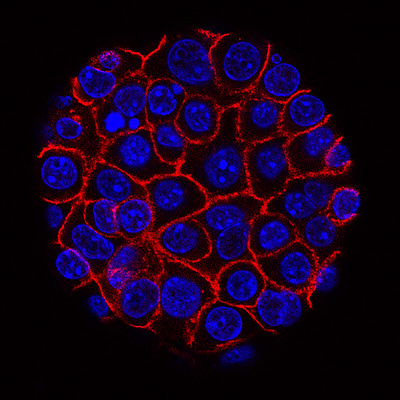This web page was produced as an assignment for an undergraduate course at Davidson College.
A new pancreatic cancer GWAS study was used to determine a new approach to advance the study of pancreatic cancer susceptibility.
Pancreatic cancer (PC) has a relatively low occurrence, but it is one of the deadliest tumors with a five-year survival rate of 3-7% in Europe. For the past couple of decades progress in managing and treating PC in patients has been insufficient. Mortality is rising and it is estimated that PC will become the second cause of cancer related deaths in the United States by 2030 (Torre et al. 2016). GWAS studies that have been conducted in the past, but only 40 germline variants in 32 loci have been identified in individuals with European descent. These variants only explain about 4% of the phenotype variance in PC. The challenge of performing PC case-control studies with adequate clinical and genetic information is that there aren’t enough studies that can be used to conduct an accurate GWAS study (Buniello et al. 2019). This means that there aren’t many genetic variants that are identified in subjects with PC. Because of the deficiencies in conducting a GWAS study, an alternative approach needs to be conducted to determine new genetic variants that are being missed by GWAS studies.
In this paper the researchers build on one of the largest GWAS studies in PC and apply a classical GWAS approach and different strategies to discover risk-variants. The researchers used an approach called the Local Moran’s Index (LMI). LMI is used to identify clusters of single nucleotide polymorphisms (SNPs) based on their risk estimates as measured by their linkage disequilibrium (LD). By capturing LD structures of nearby SNPs, the LMI will leverage the values of SNPs with low allele frequency values then conventional GWAS studies. In addition, the researchers also used 3D genomic analyses to gain insight into the inherited basis of PC. The combined uses of the conventional GWAS (1D) study along with LMI analysis (2D) and 3D genomic approaches has allowed the improvement of the discovery of novel candidate variants involved in PC genetic susceptibility.
To conduct the 1D experiment the researchers used resources from the PanGenEU case control study to recruit patients in the study that had PC. They genotyped the patients from the study and conducted quality controls for the study. Then they validified the top twenty associations identified in independent populations with 9,040 cases and 12,496 controls.
The 2D experiment was conducted by using LMI calculations for each SNP in the PanGenEu study. The 3D experiment was generating Hi-C interaction maps for both a healthy pancreas tissue and a pancreatic cancer tissue. Finally, the researchers conducted a silico functional analysis of public genomic information to allow prioritization of potentially relevant candidate variants.
Based on the combination of these three methods the researchers identified several new variants located in genes for which there is experimental evidence of their role in the biology and function of pancreatic cells. One of these genes is known as NR5A2. The researchers found a new variant in the NR5A2 gene associated with PC. They determined a meta-analysis p-value of 5.91 x 10-6 in their 1D experiment and an LMI of 7.76 in their 2D experiment, which is higher than the typical GWAS experiments. The researchers also identified new variants in a gene called CASC8 which is a lncRNA that has been association with pancreatic cancer. In the 2D and 3D experiments two new PC loci were identified which were SIAH3 and CTRB2. There were plenty of new variants that the researchers found in multiple genes and all of them showed strong silico functional analysis which means that it revealed a number of pathways related to the function of pancreatic cells and SNPs associated with novel genes in these pathways.
The researchers have expanded the scope of genomic studies in pancreatic cancer susceptibility that includes approaches that build on LMI and 3D chromatin contacts. The silico functional analysis allowed the researchers to prioritize new variants with strong biological plausibility in genes that play a key role in pancreatic cells. The researchers applied an LMI approach for the first time in the genomics field and the 3D genomic approach identified a highly potential important chromatin interacting region in XBP1. The findings from the study provide evidence that 3D genomics can contribute to identify further susceptibility loci and determine the biological relevance of SNPs.
By combining the use of the conventional GWAS analysis with LMI and 3D genomics approaches, this allows enhancing the discovery of novel candidate variants involved in pancreatic cancer. This is important in the future when it comes to determining variants not only associated in pancreatic cancer, but in other cancers and human diseases as well.
Nikhil Virani is a senior at Davidson College expected to graduate with a Bachelors degree in Chemistry in May 2021. Contact him at nivirani@davidson.edu
Resources
Buniello A., J. A. L. MacArthur, M. Cerezo, L. W. Harris, J. Hayhurst, et al., 2019 The NHGRI-EBI GWAS Catalog of published genome-wide association studies, targeted arrays and summary statistics 2019. Nucleic Acids Res 47: D1005–D1012. https://doi.org/10.1093/nar/gky1120
PanGenEU Investigators, SBC/EPICURO Investigators, E. López de Maturana, J. A. Rodríguez, L. Alonso, et al., 2021 A multilayered post-GWAS assessment on genetic susceptibility to pancreatic cancer. Genome Med 13: 15. https://doi.org/10.1186/s13073-020-00816-4
Torre L. A., R. L. Siegel, E. M. Ward, and A. Jemal, 2016 Global Cancer Incidence and Mortality Rates and Trends–An Update. Cancer Epidemiol Biomarkers Prev 25: 16–27. https://doi.org/10.1158/1055-9965.EPI-15-0578
Yu M., 2016 Pancreatic Cancer Cells.
© Copyright 2020 Department of Biology, Davidson College, Davidson, NC 28036.
